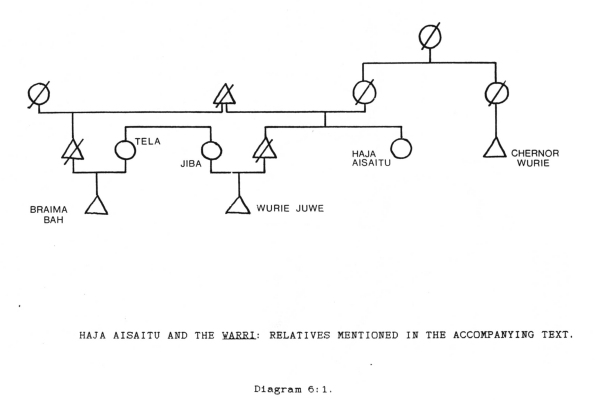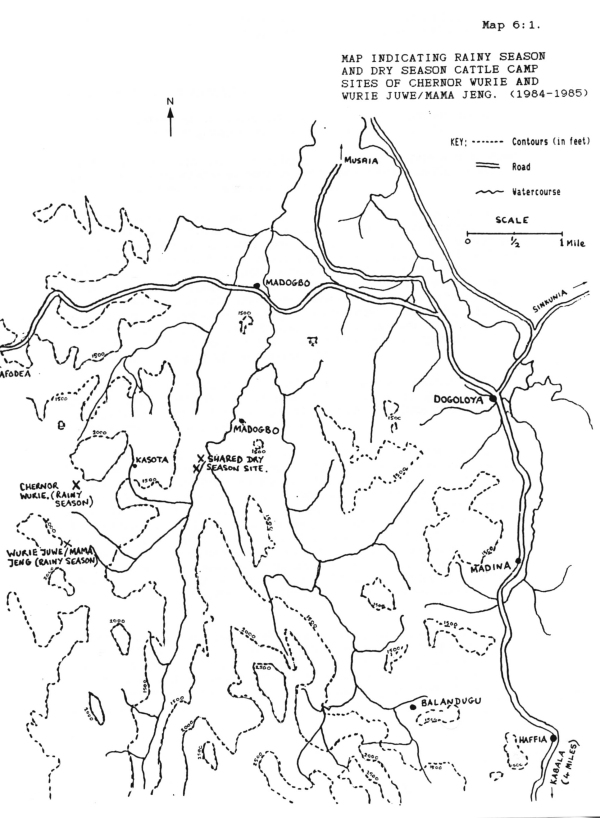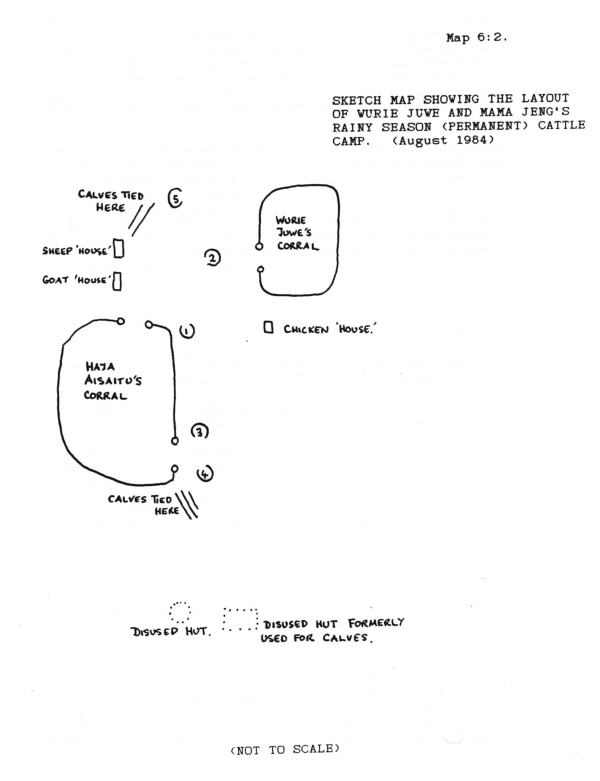 |
 |
| CHAPTER SIX "KASOTO" AND "KASEYA": THE CATTLE CAMP. |
This chapter is a general description of Haja Aisaitu's cattle camp and presents data on camp location and seasonal movements, camp composition and productive activities. Haja Aisaitu was an absentee herd owner, and had little influence over the daily running of the camp. Indeed, at the time of my research, she no longer visited the camp at all, but this was recent, an outcome, I believe, of her struggle to keep unambiguous control of her herd. |
|
93 |
| i. An introduction. Haja supported herself, and her household, from income generated by the sale of her cattle. (*1) These cattle were kept at "Madogbo", near Dogoloya, a small market town eight or nine miles north of Kabala. By road and then on foot the total distance to the warri was twelve miles, but by taking a more direct route across country, on foot, the distance was reduced to seven miles. During the dry season, with much of the "elephant grass" burnt, in preparation for next year's farms, it was possible to make the journey across country in about three hours. During the rainy season, the journey took considerably longer, but the cattle camp was never inaccessible. And yet the location of the cattle camp at "Madogbo" was both isolated and remote. Quite simply, the warri was off the beaten track, and it would have been difficult for a stranger to reach it without a guide. And, in contrast to the equally small settlements that are found along, say, the road between Kabala and Dogoloya, the warri received few visitors who were "just passing through". Whenever I travelled from the town to the cattle camp, I was always impressed by the sharp contrasts that I felt I could draw between them: the size of the settlements, their visual settings, the food, the sounds and so on. This sense of difference was undoubtedly enhanced by the fact that I always enjoyed my visits out of town. People tended to be friendlier, or at least more respectful, which really meant that I found them more willing to suffer my persistent questioning. The long, and often tiring, walk between Kabala and the cattle camps also heightened this notion of separation. Over time I began to appreciate that the town and the country were more integrated than I had imagined, and that the sharp contrasts I perceived belied the more complete picture. A variety of factors relating to "rural-urban integration" found their way into my field notes. Among them I recorded extensive kinship and affinal links, a variety of economic links, (ranging from cattle trading to the sale of milk products), and certain ritual and religious ties. Some of these issues are discussed below. My close association with Haja placed me in a good position to examine many aspects of these cross-cutting ties. Marriage to Alimamy Jalloh had brought Haja into town, yet her close consanguinal kin continued to herd cattle in the bush. However, as I noted above, Haja's relations with her out-of-town kinsmen were marked by mistrust. (See chapter three) It was many weeks before I was able to persuade Haja to allow me to visit her warri. I believe that she was concerned about what I would hear said of her and, at first, was uncertain where my allegiances would lie. Whilst Haja's confidence in me grew as the months progressed, throughout my fieldwork I felt obliged to ensure that I did not show too great an interest in the affairs of others. For this reason I made only five or six visits to Haja's cattle camp, and I never stayed longer than three nights at any one time. Fortunately, frequent visits to town by men from the warri allowed to me keep in close contact . ii. The warri; location, layout and household composition. During my fieldwork, Haja's cattle were being herded by Wurie Juwe and Mama Jeng. In the descriptions that follow, the Wurie Juwe/Mama Jeng warri is treated as a |
|
94 |
 |
|
 |
| single unit. However, Chernor Wurie, Haja's matrilateral cousin, also resided at "Madogbo". I shall also
present detailed information about this second herding unit. Wurie Juwe and Mama Jeng: "Kasoto". Kasoto is a settlement of five houses, forming a clearing among the tree savannah hillslopes, West of the Magdobo watercourse. (Please refer to Map 5:1) The following notes on personnel should be read with reference to the accompanying map (map 5:2) of the layout of the warri. Basically, the settlement consists of two family units: that of Wurie Juwe and that of Mama Jeng. Wurie Juwe was about forty years old, a fit and active herdsman. He was Haja's full brother's son. But Jiba, Wurie Juwe's mother was of slave origin, and formerly "owned" by Haja's family. Despite the general understanding that a child will take the status of his or her father, Wurie Juwe was not accepted by Haja as "real family". The closeness that one would expect from the genealogical relationship was, thus, mediated by Haja's insistence on maintaining this distance based on inherited status. Wurie Juwe and Haja certainly held differing views as to the "reality" of their relationship, but there was little in the way of their "negotiating" this reality. Haja's wealth and influence, coupled with her intransigence on this matter, made it impossible for Wurie Juwe to counter her views directly; he necessarily relied on subversion as a strategy to achieve his goals. (*2) Wurie Juwe was responsible for Haja's cattle; a responsibility he shared with Mama Jeng. (see below) But he also had his "own" small herd of cattle (approximately thirty adult cows and ten calves) along with a number of small stock (around thirty sheep and six goats), which were also kept at the warri. Wurie Juwe had three wives, all of whom were Fula. Hari, the senior wife, occupied house one. She had borne two daughters in a previous marriage, the eldest of whom was already married and living near Fadugu. The second lived with her mother. Hari had borne four children to Wurie Juwe. The eldest two were both girls, aged around eleven and nine years. The youngest were boys, around six and four years of age. Hari died shortly before I left the field, following complications that had arisen following the birth of another child. The child survived. Hari's death affected Wuri Juwe severely. Not only was she the senior and, hence, most experienced wife (bengu maudon,F.), she was also the favourite wife (bataa,F.) Wurie Juwe was left with a motherless baby. But worse still, he faced the likely prospect of Hari's cattle, which made up a sizeable proportion of his own herd, being removed by her kinsmen. Before this tragedy Wurie Juwe's position had appeared fairly secure, despite Haja's frequent threats to take her cattle and place them with another herdsman. (*3) Indeed, he had seemingly prospered. House two was occupied by Lamarana, a second wife, who had borne a daughter. House three was occupied by Binta, the third wife, who had borne two sons. Thus Wurie Juwe was at the head of a large and growing family. |
|
95 |
|
MAP 6:2 |
|
 |